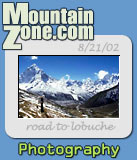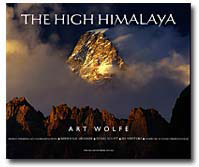
Doug Scott: 40 Years in the Himalaya
Excerpted from The High Himalaya
October 17, 2001- Seattle, Washington
|
||
Scott, at 32, was already one of the most free-thinking climbers of his generation, and the more experienced Haston was by then at the very pinnacle of the profession. The pair had reached the summit of Everest by the Southwest Face, a difficult and technical new route, to arrive at what Haston called a "unique moment in our lives." For Scott, that summit was "everything and more that a summit should be. All the world lay before us."
But the climbers had reached the top too late in the day to descend, and had actually tarried there to enjoy the view, leaving them to face a deadly experiment. That night Haston and Scott would discover whether human beings could survive, intact, a night above 28,700 feet (8,748 meters) without oxygen.
| "If I could spend the night out at the top without oxygen, then I could obviously risk spending a night out anywhere..." |
|||||
"That bivouac was crucial to me, a turning point in the way I have lived," he confided one sunny February day in 2001 as we sat in a cafè on Maid Marion Way, in the actual shadow of Nottingham Castle. Though he now lives in the Lake District, farther north, near Scotland, Nottingham was his childhood home, and the nearby crags of Derbyshire were his introduction to climbing and to life in the hills. We met there to talk over what it means to have spent the better part of 40 years in the highest mountains on earth, and with the people who live among them.
Scott, now in his late 50s, had just returned from Nepal, where he runs a trekking company, as well as a charitable trust to benefit the indigenous people of the Himalaya, with his Indian-born wife Sharu. The mountaineering achievements he made in that arena will endure along with Sir Edmund Hillary's, Reinhold Messner's, and a few others, but for Scott, the deepest rewards lie elsewhere.
"That's why what happened in 1975 was so important," he said. "It occurred to me after the bivouac on Everest that if I could spend the night out at the top without oxygen, then I could obviously risk spending a night out anywhere. That was something new, so it really did open up a world of opportunity, it widened the range of what I might do next, and, more importantly, how I might do it. I knew within myself that if I could survive a night there, I could go all over the range, and I could go much lighter, much less expensively—and therefore more frequently."
Scott already had mastered the techniques for going to remote regions with small groups of friends, and being successful. The smaller groups had made his interactions with locals more intimate, and his open, curious nature made him inherently sensitive to the cultures he encountered. Now, demonstrably free from the need for oxygen, fixed ropes and siege tactics, Scott suddenly realized the entire of the Himalaya was opened to him.
"Going to the Himalayas in that sort of lightweight style meant it could be less time consuming in terms of organization, with small teams, just friends really, and no sponsors particularly. I could go twice a year, and generally move quickly and quietly through the countryside to the climb. You just walk, you go there. That's how you get to know the people, and the place."

